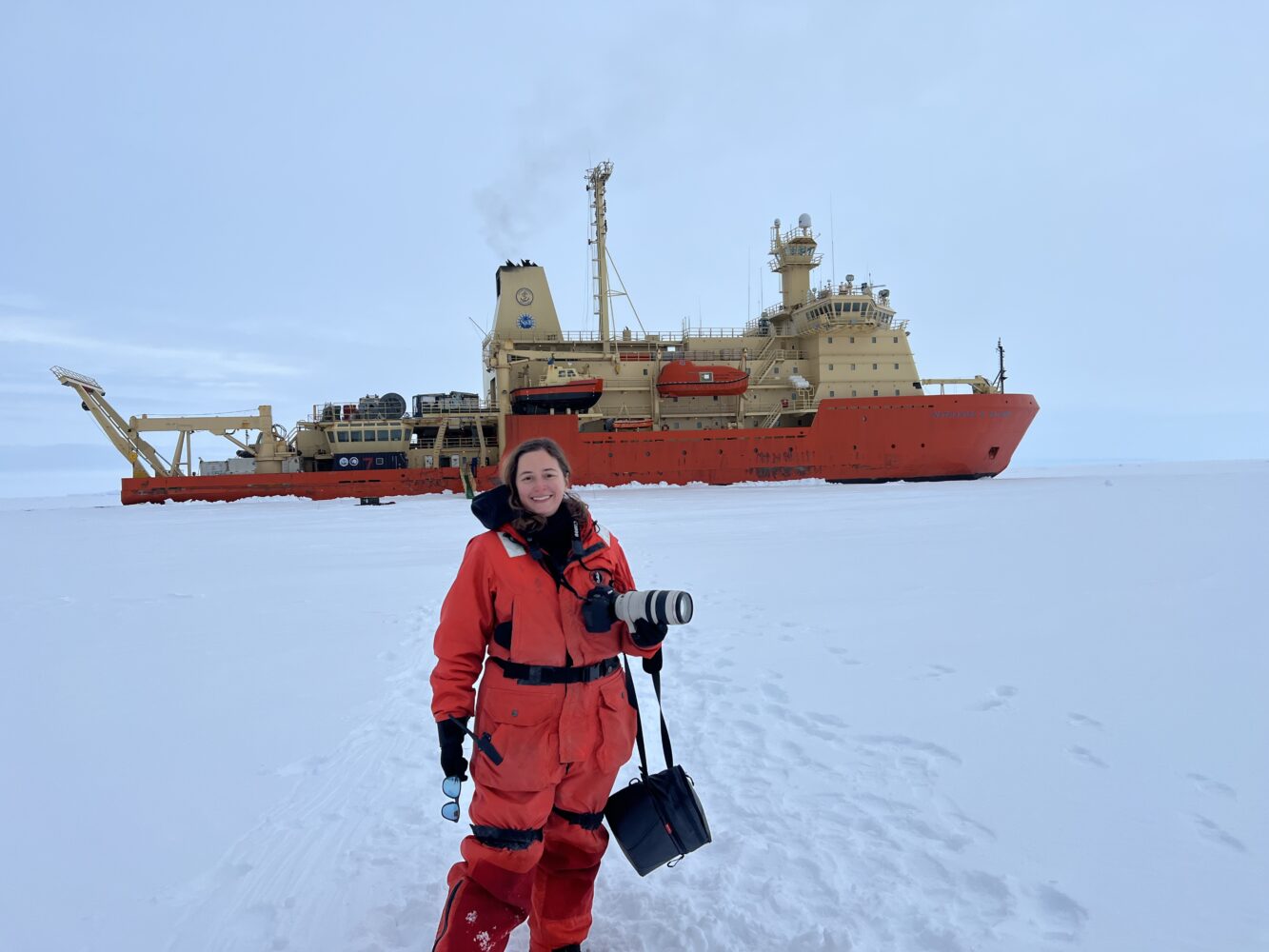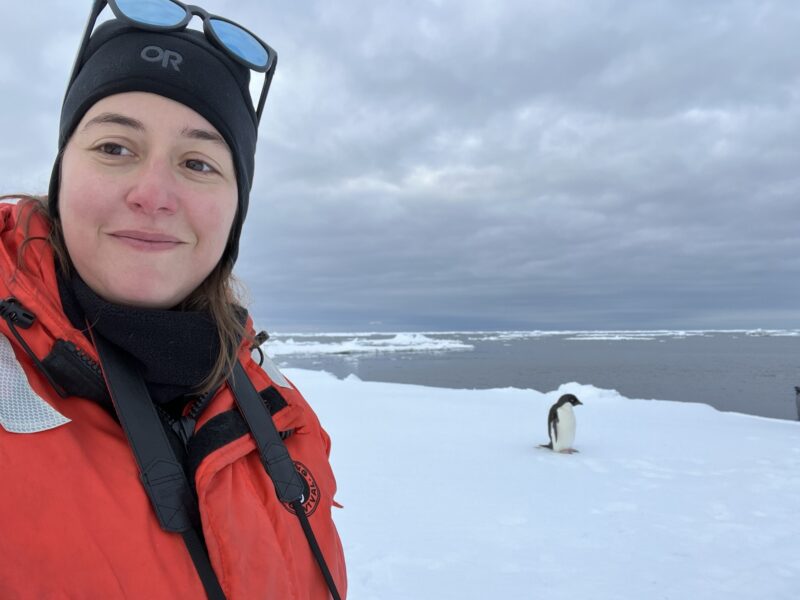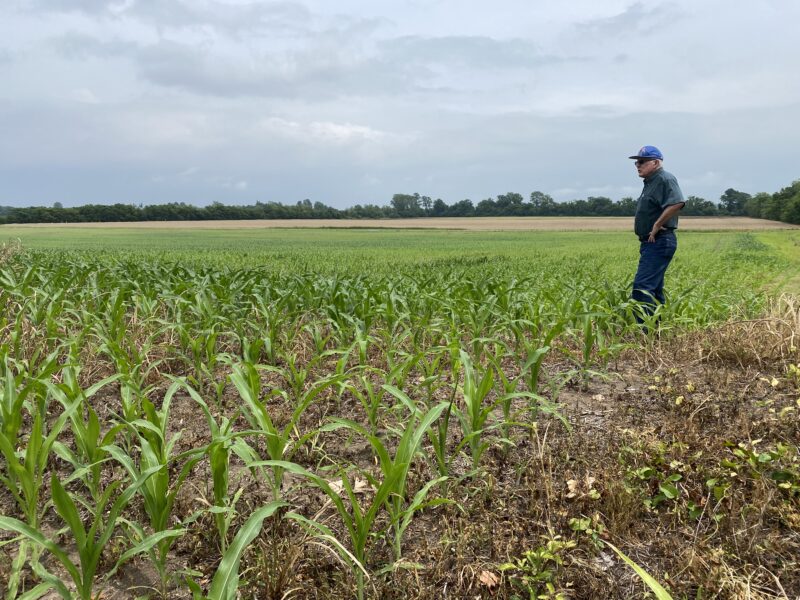
Journalists supported by CASW publish stories on Antarctic treks, nuclear power, and more
Science journalist Sofia Moutinho with the icebreaker R/V Nathaniel B. Palmer. (Photo: Sofia Moutinho)
For more than two months, science journalist Sofia Moutinho cruised through Antarctic waters on an icebreaker, watching closely as scientists in the GEOTRACES initiative collected samples of water, snow, and sea ice to better understand how climate change is altering the chemistry and biology of the oceans. Moutinho, an award-winning freelance science journalist based in Rio de Janeiro, was there thanks to a reporting fellowship from the Council for the Advancement of Science Writing, which provided mentorship and a stipend to cover direct costs and partially replace forgone income during the months at sea.
Eos magazine published her first piece from the trip—a narrative account of her and the researchers’ experiences—on May 23. It details how the researchers endured and even found joy in pursuing scientific discovery in one of the most difficult environments on the planet.
“On the one hand, there was intense work, harsh weather, isolation, and confinement,” Moutinho writes in her piece. “On the other, there was the chance to do science in a unique and wild place almost untouched by humans.”

Moutinho brought with her a full stock of reporting equipment, including photo and video cameras, sound recording devices, and microphones—some of which was almost lost when the airline flying the crew to their starting point in Chile misplaced their luggage. She was able to recover enough to record a podcast series, which will be released by Scientific American in June. Moutinho is mentored by London-based climate and environment journalist Gloria Dickie and supported by funds secured by Phoebe Lam of the University of California Santa Cruz and her fellow principal investigators on the GEOTRACES project and administered by CASW.
Other journalists funded by CASW have stories in publication this spring and summer, too. On April 23, Yale Environment 360 published an investigation by James Dinneen into the threats nuclear power plants face from increasingly extreme weather.
Dinneen’s story was supported by a reporting grant as part of a Taylor/Blakeslee Mentored Science Journalism Project Fellowship. He received mentorship from Zahra Hirji, climate reporter for Bloomberg Green, as part of his fellowship, which he won in June 2023.
Dinneen is continuing to report on how these issues are addressed at the U.S. Nuclear Regulatory Commission.
Two other Taylor/Blakeslee fellows are wrapping up stories to be published in the coming months. Freelance journalist Freda Kreier spent a week in May in Tennessee, tracing the Reelfoot fault that contributed to massive earthquakes in the New Madrid seismic zone in 1811. She is preparing a story on the current risks from this fault for Undark, with support and mentorship from environmental journalist Priyanka Runwal through a Taylor/Blakeslee Mentored Science Journalism Project Fellowship awarded in April.

And Joe Howlett, the first recipient of an enhanced Taylor/Blakeslee University Fellowship to focus on the physical sciences, is writing a story for The New York Times about the Deep Underground Neutrino Experiment. As part of his fellowship, Howlett traveled to Fermilab in Illinois and the Sanford Underground Research Facility in South Dakota, supported by CASW travel funds and mentorship from New York Times cosmic affairs correspondent Dennis Overbye.
The stories epitomize CASW’s mission to support quality science journalism, in part by building the next generation of science journalists.
“This grant offered me a unique deep dive into the background of making science, its challenges, and interesting parts,” Moutinho says. “Being confined with researchers for so long and being able to observe their work so closely made me a better science reporter, and I returned from the trip motivated and inspired to pursue new stories and formats.”